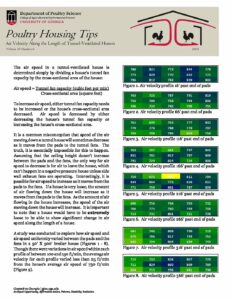The air speed in a tunnel-ventilated house is determined simply by dividing a house’s tunnel fan capacity by the cross-sectional area of the house:
Air speed = Tunnel fan capacity (cubic feet per min)
Cross-sectional area (square feet)
To increase air speed, either tunnel fan capacity needs to be increased or the house’s cross-sectional area decreased. Air speed is decreased by either decreasing the house’s tunnel fan capacity or increasing the house’s cross-section...al area.
It is a common misconception that speed of the air moving down a tunnel house will sometimes decrease as it moves from the pads to the tunnel fans. The truth, it is essentially impossible for this to happen. Assuming that the ceiling height doesn’t increase between the pads and the fans, the only way for air speed to decrease is for air to leave the house, which can’t happen in a negative pressure house unless side wall exhaust fans are operating. Interestingly, it is possible for air speed to increase as it moves from the pads to the fans. If a house is very loose, the amount of air flowing down the house will increase as it moves from the pads to the fans. As the amount of air flowing in the house increases, the speed of the air moving down the house will increase. It is important to note that a house would have to be extremely loose to be able to show significant change in air speed along the length of a house.
A study was conducted to explore how air speed and air speed uniformity varied between the pads and the fans in a 50' X 500' broiler house (Figures 1 - 8). Though there were variations in air speed within each profile of between 100 and 150 ft/min, the average air velocity for each profile varied less than 25 ft/min from the house’s average air speed of 730 ft/min (Figure 9).
There are two areas of a house where the air velocity will increase/decrease from the calculated average: that’s near the pad and tunnel fan ends of a house. As we move from the pad end wall to the tunnel fan end of the pad system opening, fresh air is continually being added to the cross-section of the house and as a result air speed will increase (Figure 10). At the tunnel fan end of the house air is being continually being removed from the house as we move past each side wall tunnel fan which results in a decrease in air speed as we approach the end wall (Figure 11). The greater a house’s air speed, the longer the pad system and the greater the number of tunnel fans a house will have. Both will result in the large reductions in air speed as you move closer to the end walls (Figure 12). Though tunnel doors can help to increase air movement in the vicinity of the pads, they cannot totally compensate for the fact that there is relatively little air moving down the house near the pad end wall. This results in relatively low air velocities near the pad end wall.
It is important to note that though the average air velocity will not decrease between the pads and the fans, the air velocity at any given location within a cross-section can increase, decrease, or vary as you move from the pads to the fans. For instance, air velocity towards the center of a house at the end of the pads will often be higher than it is near the side walls. As the air moves towards the fans, the air will tend to spread out, resulting in a decrease in air speed near the center of the house and an increase in air speed near the side walls.
Heaters, chick feeders hung on the side wall, rolled-up half house curtains, migration fences, feed hoppers, and circulation fans will also cause variations in air speed within each cross-section of a house. Since the location and positioning of these obstacles vary along the length of a house, it is only logical that air speed distribution from wall to wall and ceiling to floor would vary to some extent along the length of a house.
Since the average air speed remains constant between the pads and the fans, it can be determined at about any location. What is more important than location is the number of measurements taken within a given cross-section. The greater the number of measurements, the more accurately a house’s average air velocity can be determined
Details
| Year | Volume | Number | Categories |
|---|---|---|---|
| 2023 | 35 | 6 |

